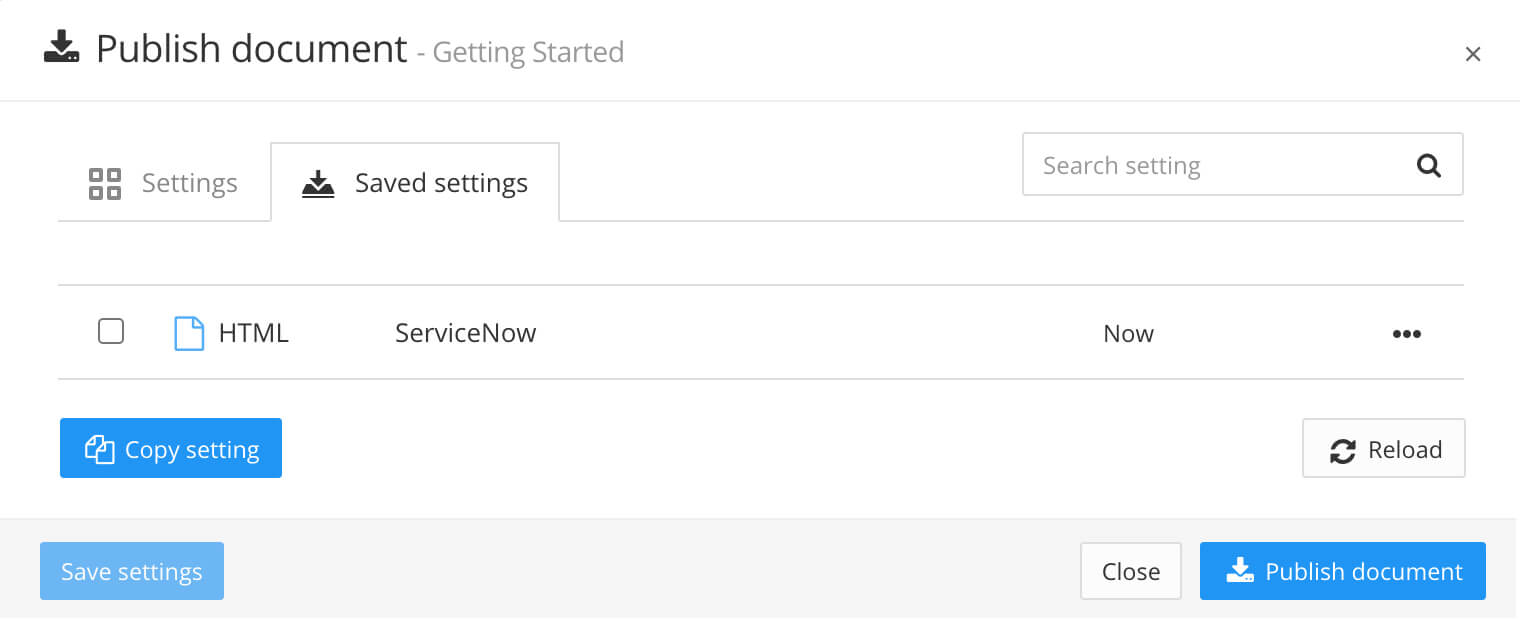Zoomin Integration
Zoomin is software that is designed to provide a single portal for all of your documentation, including PDFs, Word documents, knowledge base articles, and content you create in Paligo too.
To use your Paligo content in Zoomin, you will need a Zoomin account and then in Paligo you will need to set up:
The Zoomin integration settings, see Connect Paligo to Zoomin
A publication and topics in Paligo. These contain the content you will "push" to Zoomin.
There are no special requirements for your publication and topics when publishing to Zoomin.
You can then publish from Paligo to your Zoomin software. The content that you publish is an HTML5 output that is customized to contain metadata and other details that are needed for Zoomin.
You can publish content directly from Paligo to your Zoomin instance. But to do that, you first need to set up Paligo and Zoomin to connect to each other.
Log in to Paligo via a user account that has administrator permissions.
Sign in to Paligo using a user account that has administrator permissions.
Select the avatar in the top-right corner.

Select Settings from the menu.

Select the Integrations and webhooks tab.

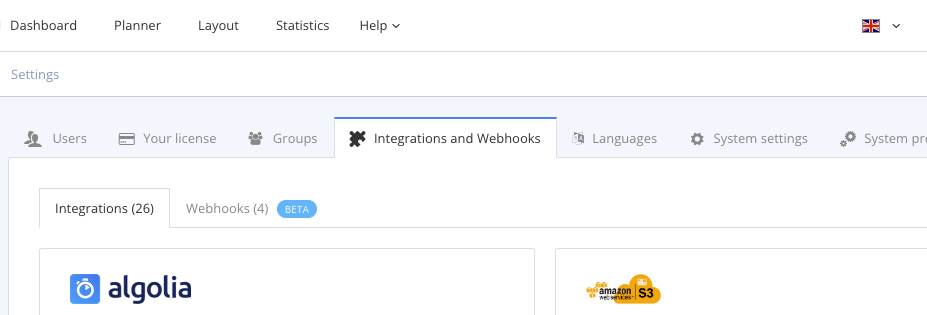
In the Zoomin box, select Add (or Change if an integration has been set up previously).
Paligo displays the integration settings.
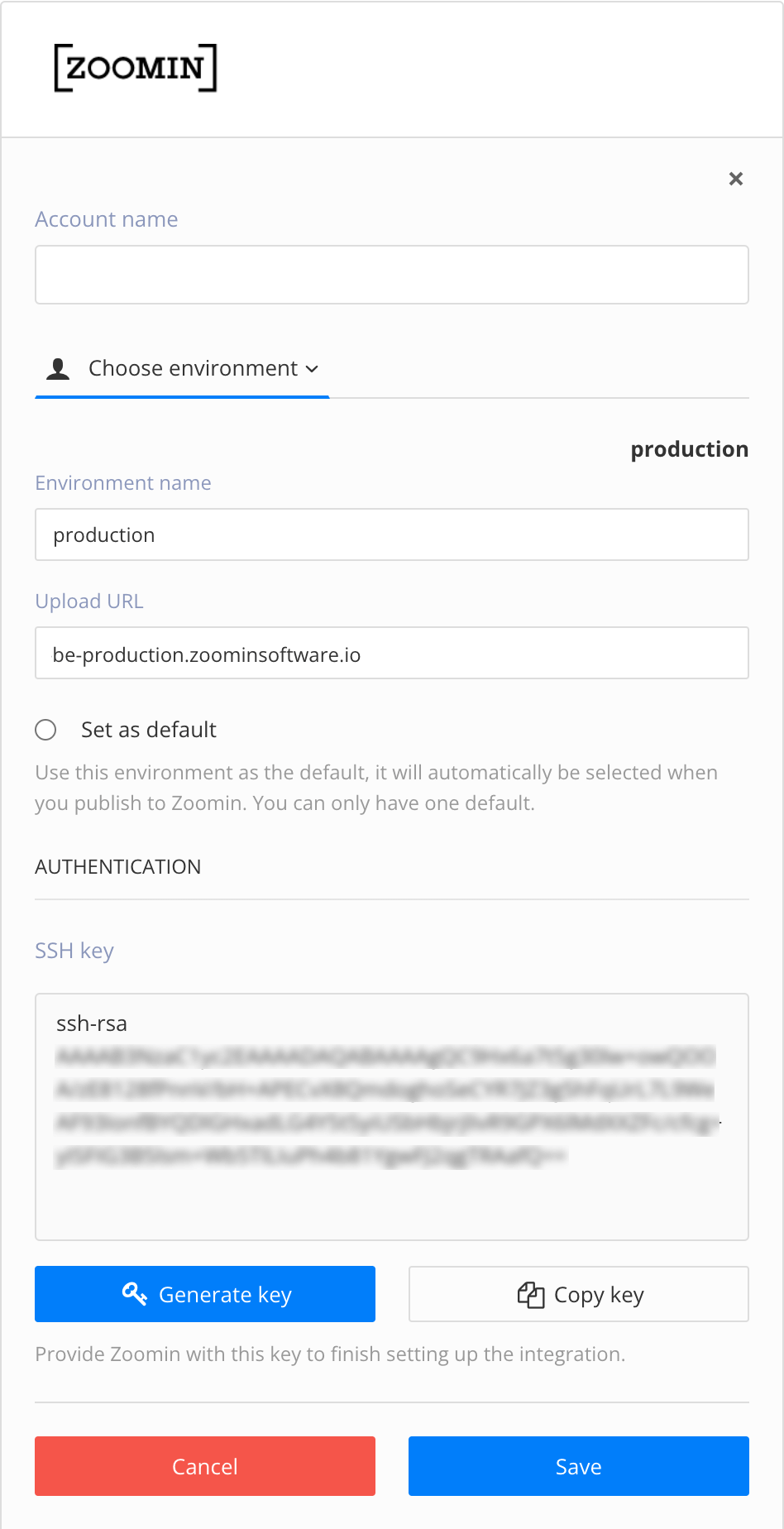
Enter the Account name.
This has to match the name of the account in Zoomin.
Use the Choose environment option to select one of the environments. You can have up to five environments.
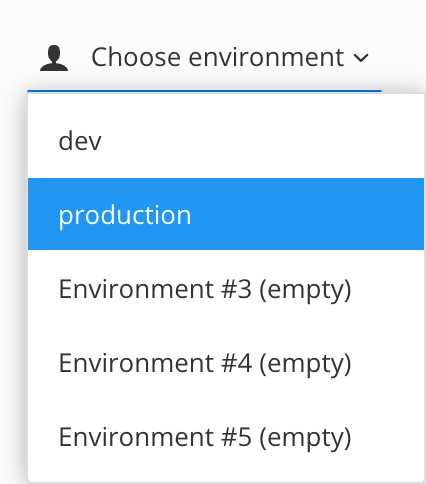
Enter:
An Environment name.
This can be any name you like and it is used to identify the environment in Paligo. We recommend that you give your environments names that make it easy for users to differentiate between your environments. This is because when you publish from Paligo, you will need to choose the environment to publish to and these are listed by name.
An Upload URL.
The upload path is the URL of the location (in Zoomin) that will receive the content that Paligo publishes.
Paligo adds a default structure for the URL path. You should overwrite it with the specific address for your Zoomin environment.
If you want the selected environment to be the default Zoomin environment for publishing, check the Set as default box. Leave it clear if you want a different environment to be the default. When you publish, you can choose a different environment if required.
Select Generate Key.
Paligo generates an SSH key. The key is shown in the SSH key box above the button. SSH stands for secure shell and it is used for encrypting your connection between Paligo and Zoomin.
Select Save.
Select Copy key to copy the SSH key. Then send the SHH key to Zoomin. Ask them to add it to your Zoomin instance. When they have added it, you return to the settings in Paligo.
Select the Change button for the integration.
Select Test Settings to run a connection test.

If the settings are:
Correct, Paligo shows a green success notification.
Incorrect, Paligo shows a red failure notification.
Check each connection setting carefully, to make sure you have not made any mistakes and try again.
If the connection test continues to fail, contact Paligo support for assistance.
Tip
When the connection test is successful, you can Publish to Zoomin.
If the connection test fails, make sure that you have entered the account name and environment details correctly, and that you have sent the SSH key to Zoomin. Check closely for typing mistakes, such as incorrect spaces or characters.
To publish Paligo content to Zoomin, you will need to use a Zoomin Layout. The Layout has settings that apply when Paligo converts your XML content into HTML, such as the number of levels in the table of contents, and whether taxonomies are included in the output.
Your Paligo instance comes with a default Layout for Zoomin. You can use this Layout for publishing or you can create your own Zoomin Layouts, with different settings in place. When you create a Zoomin Layout, you can choose whether it inherits the default values for settings from:
The default Zoomin Layout provided in Paligo
One of the custom Zoomin Layouts you (or other users) have created in Paligo.
The Zoomin Layout is loosely based on the multipage classic HTML Layout, and so includes some of the same settings. Most of the settings work in the same way on both Layouts, although some may not apply to Zoomin. The main differences are:
The Zoomin Layout adds some metadata to the output. Zoomin needs the metadata.
Your Zoomin output will include a taxonomies.xml file. Zoomin can then use any taxonomies that you have in place in Paligo.
To learn how to create your own Zoomin layout, see Create a Zoomin Layout.
To edit an existing Zoomin layout, follow the steps in Edit a Layout . You can find information on the available settings in HTML5 Layout Editor Options. But be aware that some settings may not be relevant when publishing to Zoomin.
Note
In previous versions of Paligo, the Base Layout for Zoomin was actually an HTML5 Layout. If you used it, it will continue to work. You can find it in the HTML5 category of Layouts and it is now known as Zoomin (Legacy).
To publish content to Zoomin, you need to use a Zoomin Layout. You can use the built-in Zoomin Layout or create your own. Alternatively, if your Paligo instance already contains some Zoomin Layouts, you could edit one of those and use that.
To create a Zoomin Layout:
Select Layout in the top menu.

Paligo displays a list of Layouts. The list is empty if there are no custom Layouts in your Paligo instance.
Select Create New Layout in the lower left corner.

Give your Layout a name in the Layout title field.
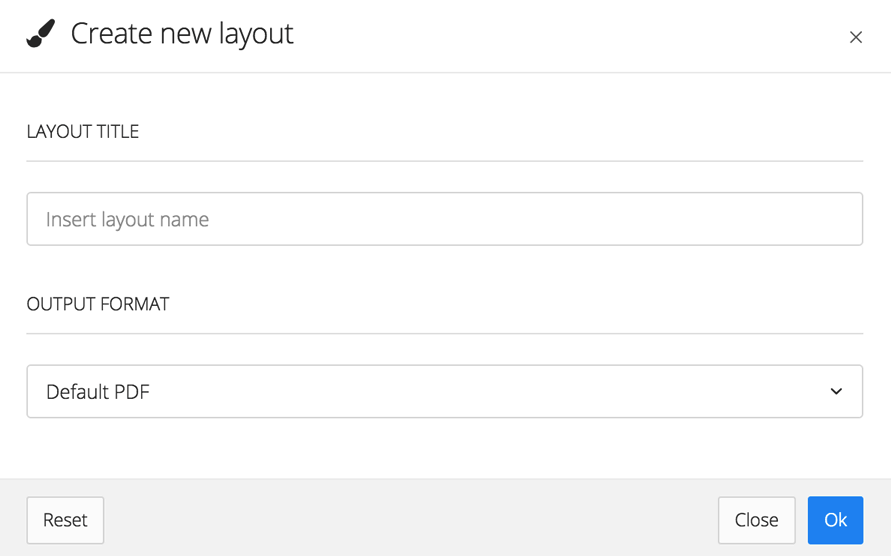
Select an Output format.
The output format is the Base Layout for your new Layout. It defines the:
Type of content that you can publish with the template.
Source of default values. If you set a value to Default in your new Layout, it means the value is inherited from the Base Layout. To learn more, see Layout Relationships - Base, New, Duplicate.
Note
You can choose whether the Base Layout is a built-in Layout or is one of your previously created custom Layouts.
Select OK.
Paligo creates your new Layout.
Select the new layout in the list to open it in the Layout Editor.
Tip
You can copy the URL from the new dialog and paste it into a browser tab. This is sometimes easier to work with, especially if you frequently switch between your content and the layout settings.
Use the Layout Editor to choose the publication settings. Paligo will apply these settings when it converts your XML content into the output format.
Zoomin layouts have the same settings as an HTML5 help center, although be aware that some of the settings may not be relevant when publishing to Zoomin.
Select Save.
Before you can publish to Zoomin, you have to:
Create a Zoomin Layout. There is a built-in Zoomin layout included in Paligo, but you may want to create your own if you have specific requirements for how the content is transformed from Paligo XML to HTML.
To publish your Paligo content to Zoomin:
Select the dotted menu (...) for the topic or publication in the Content Manager.
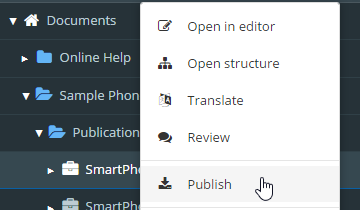
Select Publish.
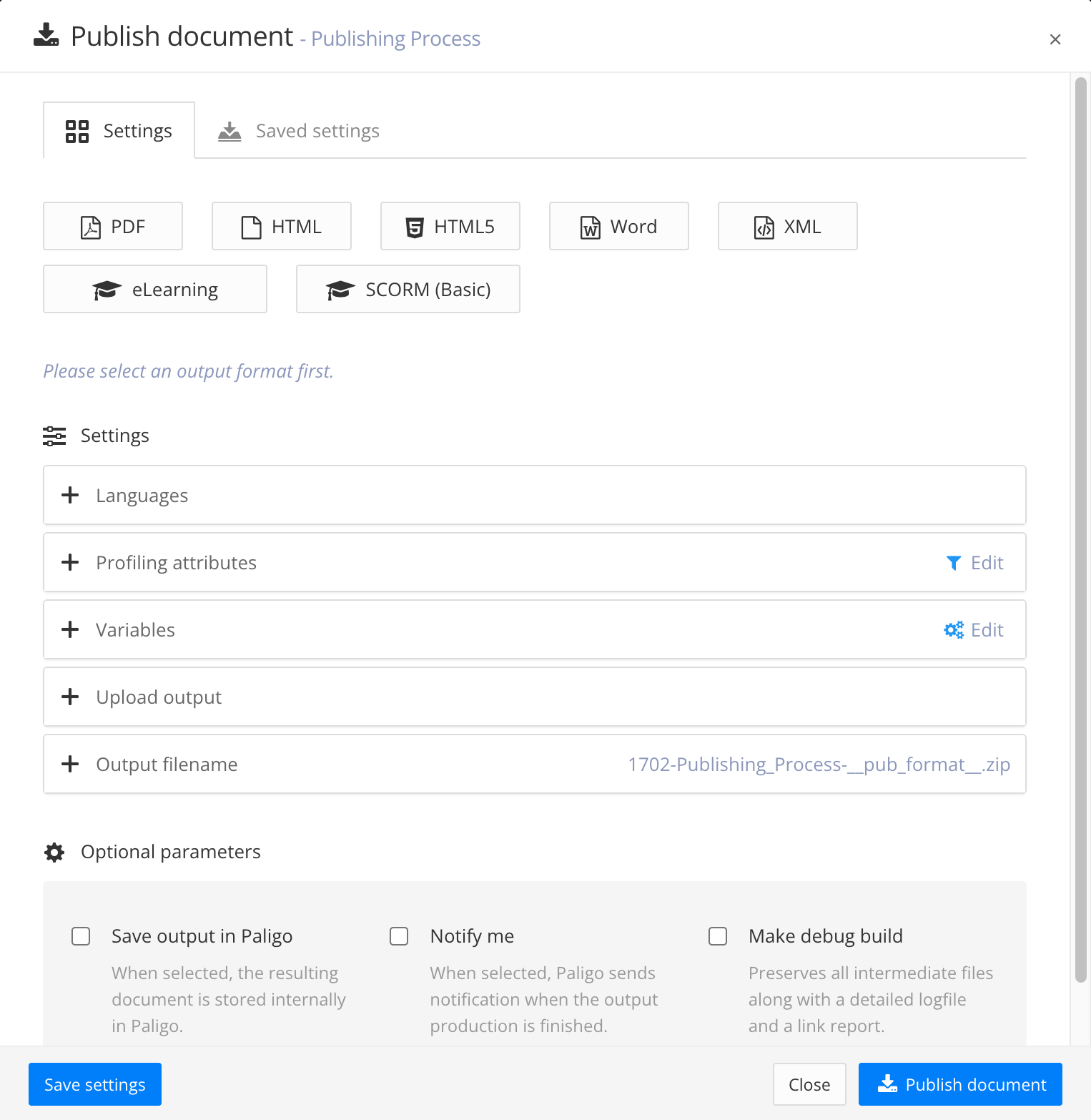
Paligo displays the Publish document dialog.
On the Settings tab, select HTML5.
Choose the Zoomin layout that you want your publication to use.
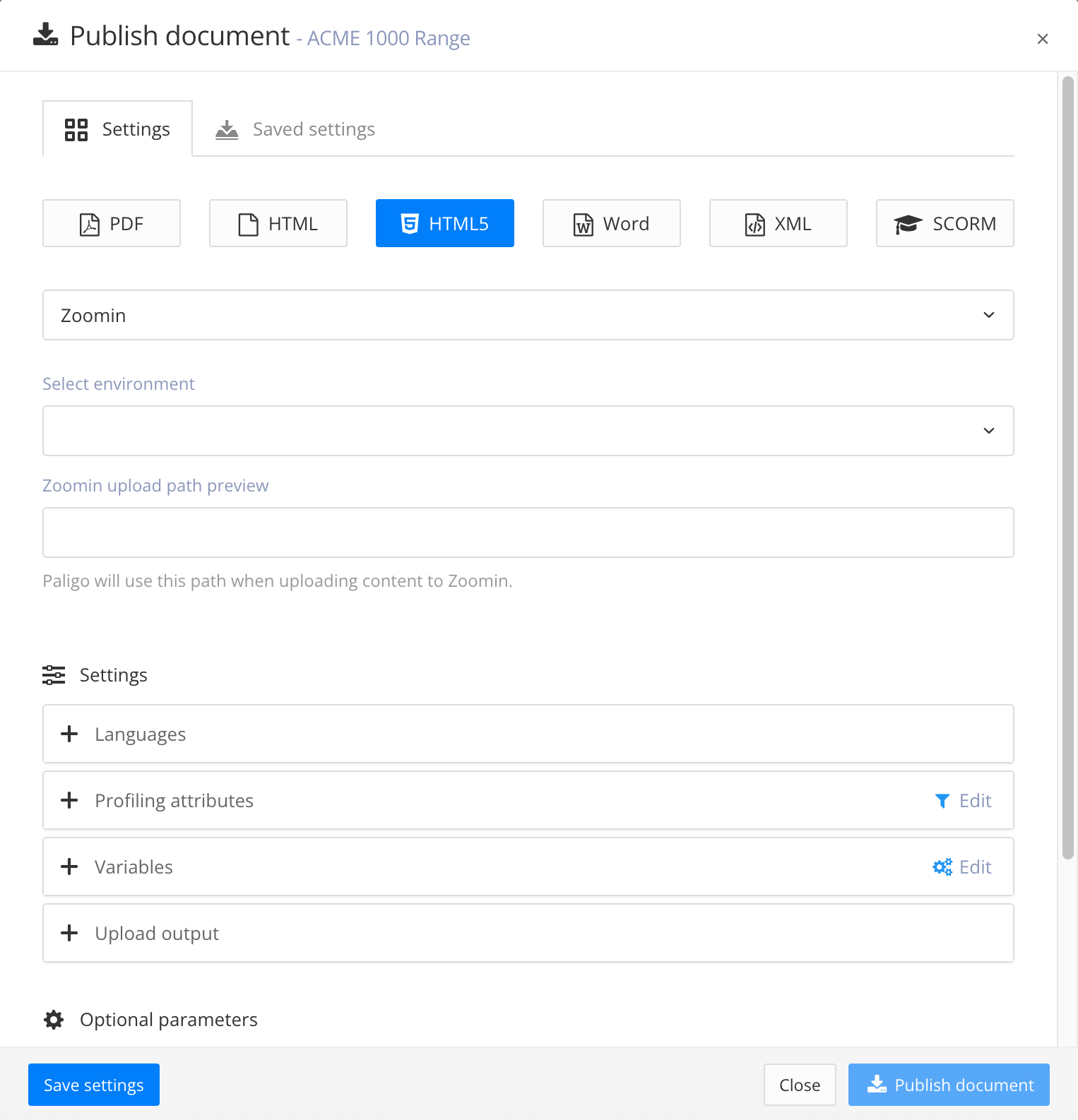
Select the Zoomin environment that will receive the published content from Paligo.
The Select environment list contains the names of each Zoomin environment that has been added to your Paligo-to-Zoomin integration settings.
When you select an environment, the Zoomin upload path preview field updates to show the location that will receive the published content. The URL for the location is also defined in the Paligo-to-Zoomin integration settings.

Select the languages to be published.

Note
If no translations are available, only the Source Language will show. If you have multiple languages translated and approved, you can select which ones to include. Paligo will publish each language as a separate output.
For PDF output you can publish them as one multilingual publication, check the Combine selected languages box.
If your content is set up to use Filtering / Profiling, use the Profiling attributes section to apply them. [Optional]. If you do not use filtering, ignore this setting.
Select Edit and then choose the value for each filter that you want Paligo to use. For example, for Audience, choose Expert to include content that is marked as for expert users.
If you do not want to apply a filter, leave the field blank.

Select OK to add your chosen profiling attribute(s).

Use the Upload output section to upload a zip file of the content to a repository, see Integrations.
Use the Output filename section to control the filename.
By default, Paligo will use the filename syntax that is defined in the System Settings.

To change the information included in the filename, enter your preferred format in the publishing settings. Default is:
ID-Title-Format.You can use:
ID - The ID of the document.
Title - The title of the publication or topic that you are publishing.
Format - The name of the output format, for example, PDF or HTML5.
Edit date - The date that the publication or topic was last edited.
Branch label - The text from the branch label for the publication or topic. This only applies if your content has been branched and it has a branch label. For details, see Add or Edit Branch Labels.
Unique value - A random string of characters, generated by Paligo, that is added to the filename to make it unique. This can stop the file from being overwritten by later publishes of the same document.
Tip
If you type @ into the field, Paligo displays a list of the available values and you can select from the list. To remove a value, click in it and use the delete key or backspace key to remove all of its characters.
Note
The filename shown in the top-right corner is a preview of the filename that Paligo will use when you publish.
Set the Optional Parameters (leave unchecked if you do not want these features):
Save the output in Paligo - Check the box to save the zip file that Paligo creates when you publish. The zip file will be available from the Resource View and you can download it from the Saved Outputs tab. Clear the box if you don't want Paligo to store the zip file.
Notify me - Check this box if you want Paligo to send you an email when the publication is ready. This is useful if you have very large publications that can take a longer time to process and publish.
Make debug build - Check this box if you want Paligo to include a log file and link report. If there is an issue with your content, Paligo support may ask you to enable this feature so that they can use the log files to investigate.
Select Publish Document.
Paligo starts processing your content and applies your layout and publishing settings. The time that this takes varies depending on how much content you are publishing (the more content, the longer it takes).

A progress bar appears. Select the arrow to hide the progress bar and reopen it by selecting the progress clock in the top menu. To abort the publish, select the X.
The published output appears as:
A ZIP file with the published output appears in the downloads folder on your computer.
If you have altered your browser's settings to store downloaded files somewhere else, the zip file will be found there instead.
If you are using a publishing integration, the zip file will also be sent to the relevant service.
A link in the Activity Feed Panel to download the published content.
Note
To make the content available online, first unzip the file. You can then use the file locally or you can use an FTP client, such as Filezilla, to upload the unzipped content to a web server.
Tip
You can save your publishing settings and reuse them to achieve a smoother publishing process, see Publishing Settings. Any settings you save can also be used for Batch Publishing.
